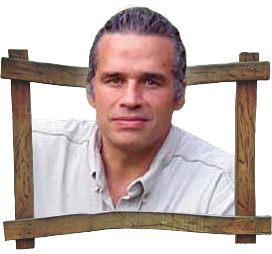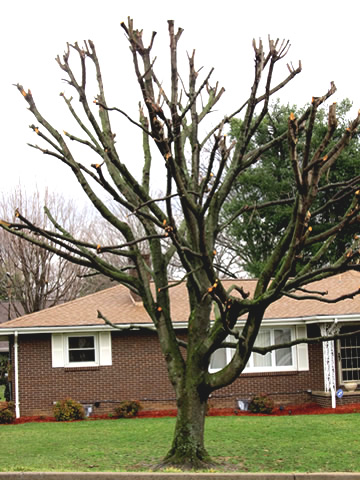Frequently Asked Questions
Click on the questions and view our answers.
Click on the questions and view our answers.
|
1. Why should I prune my trees?
Pruning is an extremely complicated process because proper pruning techniques will depend greatly on the species of tree, its age and condition, and the purpose of the pruning. Contrary to popular belief most pruning is not beneficial to a trees “health”. There are occasions where trees have either structural defects or they have outgrown their ability to hold themselves up. In either case, pruning is used to reduce the forces on a tree’s structure, thereby reducing the chances of storm damage.
In most other cases, pruning is done to meet a human need, whether it be for haard reduction by removing deadwood, creating clearance from a building or a through-way, creating beauty, shape, and light penetration, or size reduction to help fit in the landscape. Unfortunately, due to lack of proper training and inadequate climbing skills, the improper pruning of trees is a common practice in the tree care industry, which has no requirements for training or education.
Daniel takes great care in pruning trees, which includes making many smaller cuts on branch tips, rather than removing large limbs, discouraging clients from removing the lower limbs on mature trees (called elevating or raising the canopy), and also leaving (or at most thinning) water sprouts (often called suckers) whenever aesthetically acceptable. This is progressive pruning and is practiced by only the smallest minority of local tree services. Unfortunately, many of my peers are stuck in pruning practices that have been out of favor for nearly 20 years and have no desire to continue their education or improve their practices. Daniel is also an expert in pruning ornamental trees for shape and beauty.
|
||||
|
2. Are my trees safe?
This question can only be answered by an experienced professional arborist. Often times, trees may look dangerous because they are hollow, however most trees are considered safe if that hollow is 70% or less. This can depend on species and other factors such as the structure and size and weight distribution of the canopy. Other times, trees which may look perfectly healthy to the untrained eye, have serious structural defects in the roots, trunk and branch connections, which may be barely visible, even to a highly experienced arborist. An arborist should always weigh the potential for tree failure with the threat to people and property while also considering the value and benefits of any particular tree. So a big tree with small defects that is threatening a children’s play area or parked cars or a house may be considered more “dangerous” than a highly structurally compromised tree growing over an unused area of your lawn or in the woods.
Daniel has been cleaning up storm damaged trees for 30 years. He recognizes the conditions that cause tree failure and knows the susceptibilities of different species. Combining this practical experience with the latest scientific information on hazardous tree assessment makes Daniel a true expert.
|
||||
|
3. If my tree has dead branches is it dying or healthy?
There is no quick answer to this question. Healthy trees will die off and shed limbs that are no longer producing enough “food” for the tree. These tend to be lower limbs on trees in shaded areas. Dying branch tips in the upper and outer canopy are generally a sign of decline which often but not always ends in the tree’s death. If there is damage to the root system, which can be either man-made or natural, there are times when a section of the top will die but the rest of the tree remains healthy. Having an experienced arborist evaluate the tree, considering the amount of dead wood and the tree’s overall health and condition, value, etc. will give you a good idea of whether pruning or removal is an appropriate option or whether other remedial options should be utilized.
|
||||
|
4. What is the best time of year to prune trees?
Generally if a tree is not over pruned, pruning can be done at any time of year. Certain species of trees, especially Elms, may be susceptible to the spread of terminal disease if pruned while insects are active. Fruit and flowering trees may be best pruned at specific times of the year if fruit or flower bearing is a concern. When a tree has a structural defect that requires the removal of a significant amount of weight which would never be done under normal circumstances; that pruning will tend to be less detrimental to a tree’s health if done when the tree is dormant. Normally, on mature trees, pruning is best achieved by making many small reduction cuts on branch tips throughout the canopy, removing less than 10-15% of the green leafy material. Younger, more vigorous trees can have up to 25-30% of the green leafy material pruned.
Unfortunately, improper pruning practices are still extremely prevalent within the local industry as of this writing. If you hire the wrong arborist, no time of year is the proper time to have your trees pruned. Fortunately, our 75’ bucket truck and world class climbing arborists makes proper pruning, which is making small cuts on the branch tips throughout the canopy, rather than making large wounds on the tree’s main trunk or stems, fast, safe and efficient.
|
||||
|
5. How much does the tree service cost?
That all depends. There are just too many factors to give a set price. It’s always best to meet in person, discuss your needs and evaluate your trees and options. Daniel generally will price out each task separately so you know exactly what you’re paying for and what you will get. This gives you the option to pick and choose and prioritize the items you want done that meet your budget and needs.
|
||||
|
6. What is tree “topping” and is it bad for trees?
Tree topping is the practice of indiscriminately cutting a large part of the top of the tree off. It’s also called “coat racking” because the tree looks like a bunch of bare stubs which could be used to hang coats. The ISA and other professional organizations have been for years, trying to educate customers, home owners, tree owners and professional arborists about the problems associated with topping trees. Fortunately, there’s a lot less tree topping going on locally of late.
However, one must make a distinction between the indiscriminate cutting of tree topping and the precise “reduction cuts” made by a skilled and educated arborist. Reduction cuts can significantly reduce the height and spread of large limbs and leaders with minimal damage to a trees health, structure and longevity. Unfortunately, many arborists today, trained to think that “topping is bad,” are unwilling to use proper reduction cuts because they confuse that with tree topping. What they often end up doing instead is end up “gutting” a tree, which is removing all interior sprouts and branches generally in the lower half of the tree. Gutting can be as bad as or worse than topping for a tree’s long term health.
Very few tree services have either a 75’ bucket truck or the climbing skill and ability to make proper reduction cuts. Unfortunately, even some of the best known local tree care companies are still performing inferior tree care services in this regard.
Daniel has made several videos showing how proper reduction techniques is possible and how they are best achieved with a 75’ bucket truck.
PRUNING VIDEOS
|
||||
|
7. What is a Certified Arborist and why is it not enough?
‘The International Society of Arboriculture’ (ISA) promotes the professional practice of arboriculture and fosters a greater worldwide awareness of the benefits of trees. To earn an ISA Certified Arborist® credential, you must be trained and knowledgeable in all aspects of arboriculture. ISA Certified Arborist® have met all requirements to be eligible for the exam, which includes three or more years of full-time, eligible, practical work experience in arboriculture and/or a degree in the field of arboriculture, horticulture, landscape architecture, or forestry from a regionally accredited educational institute.
Daniel has met the requirements and passed the ISA Certified Arborist exam. Although the ISA touts this certification as a badge of true expertise, it’s not. In reality, it’s a test of minimal knowledge and requires almost no practical hands-on experience. There is absolutely no enforcement or oversight to ensure proper tree care practices. Although it’s good to have an ISA certification, it is by no means a guarantee of quality tree care. You really have to be careful because improper practices can do irreparable harm to trees, often resulting in early death the expensive liability of their removal. Because the average homeowner knows so little about what really is proper tree care, there are a lot of smooth talking “hacks” in the industry as well as unscrupulous business men that convince their customers to do unnecessary and detrimental work.
|


